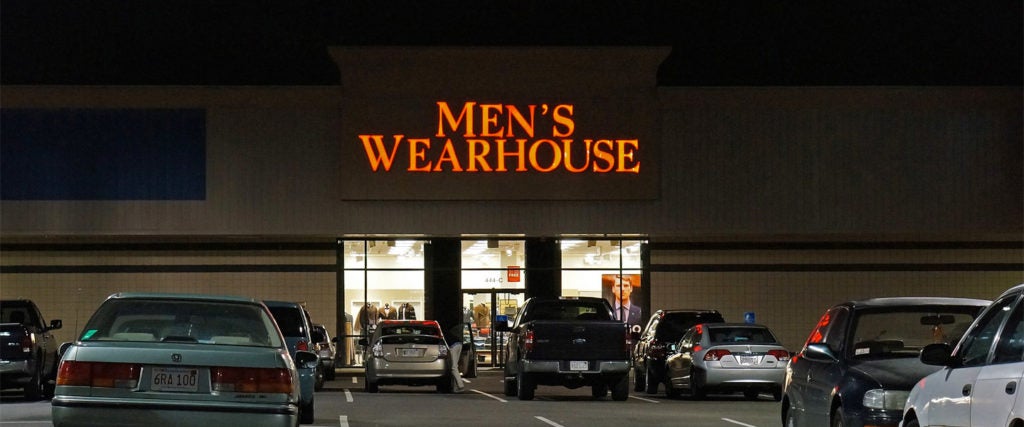Last week, Men’s Wearhouse and Jos. A. Bank filed for bankruptcy. It was a long time coming for the two menswear giants, which made a name for themselves selling affordable suits in an array of sizes. Their financial instability is the result of many changes facing menswear: relaxed workplace uniforms, the demise of the business suit and increased online shopping.
In recent years, as “bespoke” became a selling point for online niche brands, Men’s Wearhouse became the fast food of fast fashion: cheap and easy to find, but in poor taste.
The brand answered the call for the average, fashion-disinclined man (and boy) who needed standard, affordable suits for special occasions — like a prom getup or a first job interview — at stages in life in which bodies are still growing and wallets are slim.
The demise of Men’s Wearhouse, then, portends a troubling future for the state of mass-market menswear. Does the average American boy really need to buy a suit anymore?
Logically, department stores are primed to benefit from Men’s Wearhouse’s financial woes. But they’re not faring any better. It seems every week another stalwart store files for bankruptcy, including JCPenney, Lord & Taylor and Neiman Marcus.
Conversely, there’s Macy’s, which recently shut 125 stores and shed 3,900 jobs. Macy’s is one of few department stores pivoting to a growing younger clientele in an attempt to stay afloat. In March, it partnered with Danielle Bernstein, founder of the popular blog We Wore What, on an exclusive clothing line. It was an immediate success. Business of Fashion reports the collaboration made over $2.5 million in sales on the first day.
Macy’s is also one of few household brand names with a size-inclusive men’s line at an affordable price. Yet they’re missing an even more obvious demographic: Why not partner with a male fashion influencer and appeal to a younger generation?
“They have an opportunity to cater to this new market that doesn’t know where else to go,” Gianluca Russo, a freelance writer who covers size-inclusive fashion, says of Macy’s. “But it’s right now catered to older men.”
The market is there: shopping-shy men who need a suit to wear a few times a year — and still want to like the way they look, to borrow Men’s Wearhouse’s slogan — but aren’t interested in researching online retailers for garments they can’t try on in person. “If you put it in front of their eyes that all you have to do is come in and try [clothing] on, that’s going to bring them in much more,” Russo says of appealing to young men, who may not want to be put “through a process where they have to deal with sizing, colors and all that stuff.”
This is particularly true when it comes to size-inclusive menswear. Men’s Wearhouse excelled at offering an array of suits in tailored fits, not standard sizes.
For suits — a garment dependent on the perfect fit — finding size-inclusive options for boys remains an unforgiving endeavor. Even retailers that offer larger sizes often only do so for adult menswear. They rarely account for teen bodies. “Brands just don’t think young people are fat, but in fact they are — and the numbers are rising,” Russo says.
Even for teens who fit into sample-size clothes, finding an affordable, fashionable suit isn’t easy. So the fashion-inclined have started making their own.
Zach Lindsey, 21, who competed on the first season of Project Runway: Junior in 2015, first became interested in creating his own clothes after finding mall prom suits unflattering. For senior prom in 2017, Lindsey created a bespoke olive-green suit paired with a Devils Advocate lemon-printed white shirt, an Anne Klein brooch and tan Steve Madden loafers. The look was an homage to Beyoncé’s Lemonade album, and Lindsey was awarded prom king.
In retrospect, Lindsey sees he was still adhering to the lack of effeminacy in menswear. “It was still very masculine, but at that time I felt like it was pushing the box for me,” he says of his look.
Three years later, while formal-wear brands like PromGirl cater to young women, Lindsey still hasn’t seen a menswear brand focus on fashion-forward boys. “If you’re on the more masculine side, or a femme boy who doesn’t have the ability to enact on that femininity all the way, you’re in a tight spot,” he says.
When fashionable mass-market retailers like Zara or Topman can’t manage both visually interesting and well-fitted suits, piecing together a sports coat from one store with slacks from another is a circuitous route to self-expression. “The need for a traditional suit is not relevant anymore,” says Zachary Fernandez, 21, who also competed on Project Runway: Junior. He’s never gone in to get a suit tailored; instead, he wears vintage pieces picked up at thrift stores.
The likely truth is the majority of teens looking for their first suit will either settle for what’s left on the racks at Men’s Wearhouse or JCPenney blowout sales. They may also make do with what’s at Macy’s, Kohl’s or Banana Republic. What will be sacrificed is some combination of style, quality, self-expression or cost. That’s certainly not the way we’d like our next generation of impressionable fashionable men to look.

